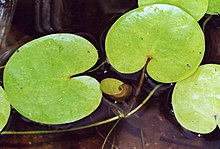Frog bite
| Frog bite | ||||||||||||
|---|---|---|---|---|---|---|---|---|---|---|---|---|

Frog bite ( Hydrocharis morsus-ranae ) |
||||||||||||
| Systematics | ||||||||||||
|
||||||||||||
| Scientific name | ||||||||||||
| Hydrocharis morsus-ranae | ||||||||||||
| L. |
The European frog bite ( Hydrocharis morsus-ranae ), usually just referred to as a frog bite , is a species of aquatic plant from the frog-bite family (Hydrocharitaceae). There are three to six species within the genus Hydrocharis . In addition, American frog-bite species are often used in aquaristics, but they belong to a different genus ( Limnobium ). Other relatives from the same family are the crab claw and the waterweed species.
features
The leaves, which look like tiny water lily leaves or are reminiscent of the snout shape of a frog, grow from rosettes floating in the water and float on the surface of mostly stagnant water. They have a diameter of about two to seven centimeters, are round to kidney-shaped, leathery-coarse, glossy green on the top, often slightly reddish on the underside and each have two large stipules. Due to the intensive formation of 5 to 20 centimeters long runners, which in turn drift runners at their ends, the rosettes hang together submerged in large associations as floating leaf carpets. The roots usually do not reach the bottom of the water, but take up nutrients from the free water.
The flowers have a diameter of about 1.5 to 3 centimeters and consist of three white petals and a bract; the base is yellow. The plants are monoecious ( monoecious ) - however, the larger male flowers (stalked in threes) and the smaller female flowers (sitting individually) are spatially separated because they grow on different stem axes. The flowering time is in the middle of summer. The globular, green fruit is about an inch tall; However, seeds are seldom formed (especially in warm years). Winter buds serve primarily to perpetuate and spread the annual species (see below).
The number of chromosomes is 2n = 28.
distribution
The original range of the frog bite extends from Europe to the Caucasus and also includes North Africa. The frog bite occurs moderately often in the lowlands of Germany, with a focus on the floodplains of the larger rivers. The plant is rare in the hills and mountains and is absent for large areas. It is regionally on some Red Lists of endangered species. In North America, the European frog bite is considered an invasive neophyte, at least in the east of the Canadian province of Ontario .
Location requirements and life cycle
Hydrocharis morsus-ranae grows in sheltered locations in floating leaf communities in warm, nutrient-rich, but not excessively polluted, mostly lime-poor, stagnant or at most weakly flowed waters over muddy ground. These include, for example, oxbow lakes, ditches that are not cleared annually or not too early, low bogs, peat cuttings and pools, but also quiet bays of flowing waters and reed beds. It is often associated with the crab claw, but it occurs much more consistently overall. It is a character species of the Hydrocharitetum morsus-ranae from the Lemnion association.
The rosette associations only drift on the water surface during the growing season . In autumn, up to a centimeter long, starchy, horn-like solidified winter buds, so-called turions, form . These detach and sink to the bottom of the water, while the remaining parts of the shoot die off. In the coming late spring (April / May) new plants develop from the winter buds, which rise to the surface and unfold. The vegetative reproduction through growth (daughter plants on long runners) and through the formation of winter buds is much more important for the species than sexual reproduction (see also crab claws ).
use
Frog bite is a popular ornamental plant in garden ponds.
Surname
The Dutch name is Kikkerbeet, which means exactly the same thing as Froschbiss in German. This is also the case in some other languages, such as English or Norwegian.
Others
The European frog bite is aquatic plant of the year 2019.
literature
- Annick Garniel: Aquatic Plants of Rivers and Ditches. Information on understanding your life strategies as a basis for conservation and support measures in Schleswig-Holstein and Hamburg. Reports of the Botanical Association of Hamburg 24 (2008): 221 S. ISBN 978-3-932681-51-6
- Eckhard Garve: Atlas of the endangered fern and flowering plants in Lower Saxony and Bremen. Nature conservation landscape conservation Lower Saxony 30, Hanover 1994. ISBN 3-922321-68-2
- Henning Haeupler , Thomas Muer: picture atlas of the fern and flowering plants of Germany (= the fern and flowering plants of Germany. Volume 2). Published by the Federal Agency for Nature Conservation. Ulmer, Stuttgart 2000, ISBN 3-8001-3364-4 .
- Elfrune Wendelberger: Plants of the wetlands. BLV-Intensivführer, Munich 1986. ISBN 3-405-12967-2
Individual evidence
- ↑ a b Erich Oberdorfer : Plant-sociological excursion flora for Germany and neighboring areas . With the collaboration of Angelika Schwabe and Theo Müller. 8th, heavily revised and expanded edition. Eugen Ulmer, Stuttgart (Hohenheim) 2001, ISBN 3-8001-3131-5 , pp. 114 .
- ↑ Rafaël Govaerts (Ed.): Hydrocharis morsus-ranae. In: World Checklist of Selected Plant Families (WCSP) - The Board of Trustees of the Royal Botanic Gardens, Kew . Retrieved August 17, 2016.
- ↑ European Frog-bit, Hydrocharis morsus-ranae . Ontario's Invading Species Awareness Program (www.invadingspecies.com), 2012.
Web links
- Frog bite. In: FloraWeb.de.
- Frog bite . In: BiolFlor, the database of biological-ecological characteristics of the flora of Germany.
- Profile and distribution map for Bavaria . In: Botanical Information Hub of Bavaria .
- Hydrocharis morsus-ranae L., map for distribution in Switzerland In: Info Flora , the national data and information center for Swiss flora .
- Distribution in the Netherlands [1] (Dutch)
- Map for worldwide distribution at linnaeus.nrm.se.
- Thomas Meyer: Data sheet with identification key and photos at Flora-de: Flora von Deutschland (old name of the website: Flowers in Swabia )




